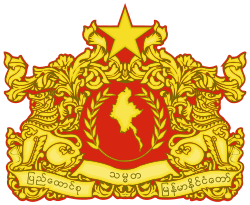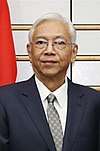President of Myanmar
The president of the Republic of the Union of Myanmar (Burmese: နိုင်ငံတော် သမ္မတ; MLCTS: nuing ngam tau samma.ta.) is the head of state and head of government of Myanmar and leads the executive branch of the Burmese government, and heads the Cabinet of Myanmar.
| President of the Republic of the Union of Myanmar ပြည်ထောင်စု သမ္မတ မြန်မာနိုင်ငံတော် သမ္မတ | |
|---|---|
 State seal of Myanmar | |
| Style | His excellency (For international correspondence) |
| Member of | Cabinet National Defence and Security Council |
| Residence | Presidential Palace |
| Seat | Naypyidaw |
| Nominator | Assembly of the Union |
| Appointer | Presidential Electoral College |
| Term length | Five years, renewable once |
| Constituting instrument | Constitution of Myanmar |
| Inaugural holder | Sao Shwe Thaik |
| Formation | 4 January 1948 |
| Deputy | Vice President of Myanmar |
| Salary | K5 million / month[1] |
| Website | www |
 |
|---|
| This article is part of a series on the politics and government of Myanmar |
|
|
Government
|
|
|
Related topics |
The president is elected by members of parliament, not by the general population. The Presidential Electoral College, a three committee body, elects the president.[2] Each of the three committees, made up of Amyotha Hluttaw, Pyithu Hluttaw members of parliament, or military-appointed lawmakers, nominates a candidate for presidency.[2] The candidate with the highest number of votes from the Electoral College is elected president, while the two other candidates become vice-presidents.[2]
The incumbent president is Win Myint. While he is the head of state and de jure head of government, the de facto head of government and the dominant state figure is the State Counsellor of Myanmar and leader of the ruling National League for Democracy, Aung San Suu Kyi.
Qualifications
According to the Constitution of Myanmar, the president:
- shall be loyal to the Union and its citizens;
- shall be a citizen of Myanmar who was born of both parents who were born in the territory under the jurisdiction of the Union and being Myanmar Nationals;
- shall be an elected person who has attained at least the age of 45;
- shall be well acquainted with the affairs of the Union such as political, administrative, economic and military;
- shall be a person who has resided continuously in the Union for at least 20 years up to the time of his election as President
(Proviso: An official period of stay in a foreign country with the permission of the Union shall be counted as a residing period in the Union) - shall he himself, one of the parents, the spouse, one of the legitimate children or their spouses not owe allegiance to a foreign power, not be subject of a foreign power or citizen of a foreign country. They shall not be persons entitled to enjoy the rights and privileges of a subject of a foreign government or citizen of a foreign country;
- shall possess prescribed qualifications of the President, in addition to qualifications prescribed to stand for election to the Hluttaw.
Moreover, upon taking oath in office, the president is constitutionally forbidden from taking part in any political party activities (Chapter III, 64).
Election process
The president is not directly elected by Burmese voters; instead, he is indirectly elected by the Presidential Electoral College (သမ္မတရွေးချယ်တင်မြှောက်ရေးအဖွဲ့), an electoral body made of three separate committees. One committee is composed of MPs who represent the proportions of MPs elected from each Region or State; another is composed of MPs who represent the proportions of MPs elected from each township population; the third is of military-appointed MPs personally nominated by the Defence Services' commander-in-chief.
Each of the three committees nominates a presidential candidate. Afterward, all the Pyidaungsu Hluttaw MPs vote for one of three candidates—the candidate with the highest number of votes is elected president, while the other two are elected as vice-presidents.
This process is similar to the one prescribed by the 1947 Constitution, in which MPs from the Parliament's Chamber of Nationalities and Chamber of Deputies elected the president by secret ballot.[3] The President was then responsible for appointing a prime minister (on the advice of the Chamber of Deputies), who was constitutionally recognised as the head of government and led the Cabinet.
History
Prior to 1863, different regions of modern-day Burma were governed separately. From 1862 to 1923, the colonial administration, housed in Rangoon's Secretariat building, was headed by a chief commissioner (1862–1897) or a lieutenant-governor (1897–1923), who headed the administration, underneath the governor-general of India.[4]
From 31 January 1862 to 1 May 1897, British Burma was headed by a chief commissioner. The subsequent expansion of British Burma, with the acquisitions of Upper Burma and the Shan States throughout this period increased the demands of the position, and led to an upgrade in the colonial leadership and an expansion of government (Burma was accorded a separate government and legislative council in 1897).[5]
Consequently, from 1 May 1897 to 2 January 1923, the province was led by a lieutenant governor. In 1937, Burma was formally separated from British India and began to be administered as a separate British colony, with a fully elected bicameral legislature, consisting of the Senate and House of Representatives. From 2 January 1923 to 4 January 1948, British Burma was led by a Governor, who led the cabinet and was responsible for the colony's defence, foreign relations, finance, and ethnic regions (Frontier Areas and Shan States). From 1 January 1944 to 31 August 1946, a British military governor governed the colony. During the Japanese occupation of Burma from 1942 to 1945, a Japanese military commander headed the government, while the British-appointed governor headed the colony in exile.
Burma became independent in 1948. There was a president from 1948 to 1962, and then 1974 and 1988. Between 1962 and 1974 and between 1988 and 2011, Burma was headed by military regimes. The office of the president was restored in 2011.
List of presidents (2011–present)
| No. | Portrait | Name (Born–Died) |
Term of Office | Political Party | Cabinet | Assembly | |||
|---|---|---|---|---|---|---|---|---|---|
| Took Office | Left Office | Days | |||||||
| 1 |  |
Thein Sein (1945–) |
30 March 2011 | 30 March 2016 | 1827 | Union Solidarity and Development Party | I | USDP—Mil. | 1 (2010) |
| First democratically elected president. Defeated at the 2015 general election. | |||||||||
| 2 |  |
Htin Kyaw (1946–) |
30 March 2016 | 21 March 2018 | 721 | National League for Democracy | II | NLD—Mil. | 2 (2015) |
| First civilian president. While he was the head of state and de jure head of government, the de facto head of government and primary state figure is the State Counsellor of Myanmar and leader of the ruling NLD Aung San Suu Kyi. Resigned due to health issues. | |||||||||
| - |  |
Myint Swe (Acting) (1951–) |
21 March 2018 | 30 March 2018 | 9 | Union Solidarity and Development Party | II | NLD—Mil. | |
| Became acting president according to the constitution after the resignation of Htin Kyaw. | |||||||||
| 3 |  |
Win Myint (1951–) |
30 March 2018 | Incumbent | 820 | National League for Democracy | III | NLD—Mil. | 3 (2018) |
| Elected on 28 March 2018 by the Pyidaungsu Hluttaw after resigning as Speaker of the House of Representatives. | |||||||||
Latest election
On 15 March 2016, the Assembly of the Union elected Htin Kyaw as the 9th president of Myanmar. He resigned on 21 March 2018 and Myint Swe became acting president.
On 28 March 2018, the Assembly of the Union elected Win Myint as the 10th president of Myanmar.
See also
- Myanmar
- Politics of Myanmar
- List of colonial governors of Burma
- List of Presidents of Myanmar
- Vice President of Myanmar
- Prime Minister of Myanmar
- State Counsellor of Myanmar
- Lists of office-holders
References
- https://www.mmtimes.com/news/nld-cuts-salaries-mps-ministers-saves-nearly-k6b.html
- "FACTBOX – Myanmar's new political structure". Reuters. 31 January 2011. Retrieved 21 August 2011.
- The Constitution of the Union of Burma Archived 30 June 2015 at the Wayback Machine (1947), Chapter V: The President
- Taylor, Robert H. (2009). The State in Myanmar. NUS Press. pp. 75–76. ISBN 978-9971-69-466-1.
- Nisbet, John (1901). Burma under British rule—and before. 1. A. Constable & Co., ltd. pp. 220–221.